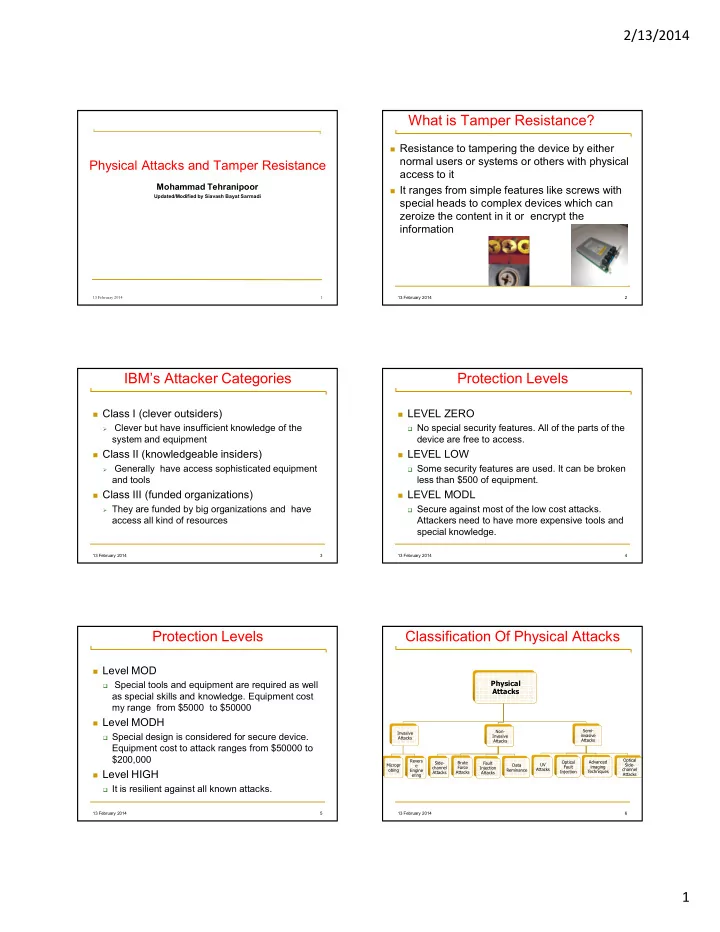

2/13/2014 What is Tamper Resistance? � Resistance to tampering the device by either normal users or systems or others with physical Physical Attacks and Tamper Resistance access to it �������������������� � It ranges from simple features like screws with ��������������������������� ����� ������� special heads to complex devices which can zeroize the content in it or encrypt the information ���������������� � 13 February 2014 2 IBM’s Attacker Categories Protection Levels � Class I (clever outsiders) � LEVEL ZERO � Clever but have insufficient knowledge of the � No special security features. All of the parts of the system and equipment device are free to access. � Class II (knowledgeable insiders) � LEVEL LOW � Generally have access sophisticated equipment � Some security features are used. It can be broken and tools less than $500 of equipment. � Class III (funded organizations) � LEVEL MODL � They are funded by big organizations and have � Secure against most of the low cost attacks. access all kind of resources Attackers need to have more expensive tools and special knowledge. 13 February 2014 3 13 February 2014 4 Protection Levels Classification Of Physical Attacks � Level MOD � Special tools and equipment are required as well ��������� ������� as special skills and knowledge. Equipment cost my range from $5000 to $50000 � Level MODH �� �� ���� ��������� � Special design is considered for secure device. ��������� ��������� ������� ������� ������� Equipment cost to attack ranges from $50000 to $200,000 #������� ������ ����� #������� ��������� ����� ������ !"� ����� ������� �� ����� ������ ������ � ������ �������� ���������� ������� �������� � Level HIGH ����� ������ �� ������ ������� ��������� $�����%���� ������� ������� ������� ����� � It is resilient against all known attacks. 13 February 2014 5 13 February 2014 6 1
2/13/2014 Non=Invasive Attacks Non=Invasive Attacks &������ &������ ������ ������ � Do not require decapsulation of the device, so it is non=destructive �����'������� � Do not require any initial preparation of the ������������ ������� ������� (&�)�������*���� device under test. ������� ($� ����������� (������� �������� � They can be done by tapping on a wire or � �������������� +������������� plugging the device in the test chip. � Easley reproducible, so that they are not !������������� expensive ��������� ��������������� � However, it can take a lot of time to find an '������� attack on an any particular device. ����*�����,� 13 February 2014 7 13 February 2014 8 Invasive Attacks Invasive Attacks � Penetrative attacks: expensive to perform � Tools � require expensive equipment, knowledgeable � IC soldering/desoldering station attackers and time � simple chemical lab and high=resolution optical � almost unlimited capabilities to extract information microscope from chips and understand their functionality � wire bonding machine, laser cutting system, � leave tamper evidence of the attack or even destroy microprobing station the device � oscilloscope, logic analyser, signal generator � getting more demanding as the device complexity � scanning electron microscope and focused ion increases and the size shrinks beam workstation 13 February 2014 9 13 February 2014 10 Semi=Invasive Attacks Semi=Invasive � Relatively new type of attack, it fills the gap ��������� ��������� #������������ #������������ !"�-����� !"�-����� #������������� #������������� between non=invasive and invasive attacks � ������ � ������ '������� '������� ������� ������� ��������� ��������� $�����%��� $�����%��� ����*��� ����*��� � Similar to the invasive attacks, they requires depackaging of the device ��������������������� ���-����������������� ����������.���������� #������������.� � But, the attacker do not need to have ����������������� ������������*� �������� ������� .�� ���������� ���� �����������)���� .�� ��������������� ����� expensive tools such as FIB. !��������������� �������*�.�������� �&�#������������ �� � Actually, these attacks are not entirely new ������ �����/#$&0� ��������������� -�������������� since UV light is used to disable security ������%�������� �����.�������)���� �������*�����*��� fuses in EPROM for many years 13 February 2014 11 13 February 2014 12 2
Recommend
More recommend